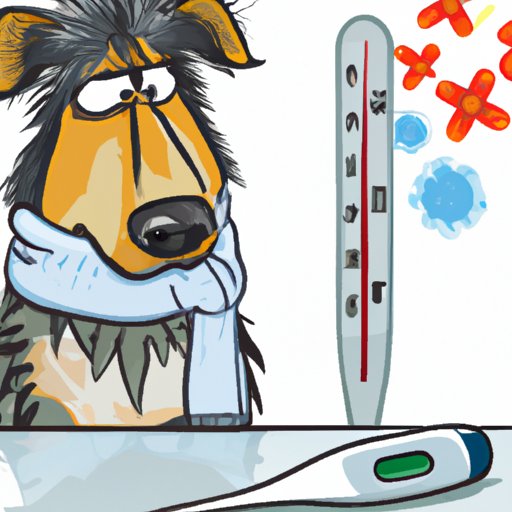
Introduction
As a pet owner, it’s important to stay vigilant about your furry friend’s health. But what happens when your dog appears under the weather and you don’t have a thermometer handy? It can be tricky to tell whether or not your pup has a fever without this essential tool. In this article, we’ll explore various tips and tricks for identifying fever symptoms in dogs, so you can take the necessary steps to help your pet feel better.
Observing Physical Symptoms
One of the most noticeable signs of fever in dogs is a warm, dry nose. In addition to this tell-tale symptom, you might also observe lethargy, loss of appetite, vomiting, and coughing. These symptoms can indicate a fever because when a dog’s body temperature is elevated, their immune system is working hard to combat a potential illness. As a result, they may feel less energetic and may experience digestive issues or coughing due to congestion.
Using the Ear Test
Another method for identifying a fever in dogs is through the ear test. To do this, gently touch the inside of your dog’s ear and feel for warmth. A feverish ear will feel noticeably warmer than a warm, but otherwise, normal ear. Make sure to check both ears for consistency, as one ear may be warmer due to factors unrelated to a fever (like sun exposure).
Monitoring Behaviors
A fever can also cause your pup to exhibit certain behaviors that are out of the ordinary for them. Increased panting, shaking, trembling, and other signs of discomfort or pain could all indicate a fever. Your dog may also seek out cool surfaces or shade to alleviate their symptoms. These changes occur because your dog’s body is working hard to regulate its temperature, which can lead to these behaviors.
Checking for Dehydration
When a dog has a fever, they are more susceptible to dehydration. If your pup is experiencing symptoms of a fever, make sure to check for signs of dehydration. This can include a dry nose and mouth or less urination. To check if your dog is dehydrated, gently pinch the skin on the back of their neck. If it stays elevated for several seconds, this can indicate dehydration.
Seeing the Vet for a Check-Up
It’s important to note that while these methods are helpful in identifying a fever, they are not a substitute for professional veterinary care. If your dog is exhibiting persistent symptoms of a fever or has a high fever, it’s wise to seek out professional advice. Additionally, if your dog has other underlying health concerns, it’s important to consult with your vet to ensure that your pup is receiving the best care possible.
Using a Surface Thermometer
While we’ve explored numerous methods for identifying a fever without a thermometer, there are some alternative methods available to you. A surface thermometer can be used to measure your dog’s overall body temperature by taking readings from various parts of their body. While this method can be helpful, it’s important to note that it may not be as accurate as a rectal thermometer. Careful use and calibration are necessary to ensure the most accurate results.
Checking Your Dog’s Gums
Another way to identify if your dog has a fever is by examining their gums. In general, a dog’s gums should appear pink and healthy. However, if your dog has a fever, you may notice that their gums are pale white or yellow. This change in gum color can be indicative of an underlying issue that should be addressed by a vet.
Conclusion
Keeping an eye out for fever symptoms in dogs can be a helpful way to ensure that your pet is healthy and happy. While there are numerous ways to identify a fever without a thermometer, it’s important to seek out professional veterinary care when needed. By staying attuned to your dog’s behavior and physical symptoms, you’ll be able to provide the appropriate care and support your furry friend needs to recover quickly.




